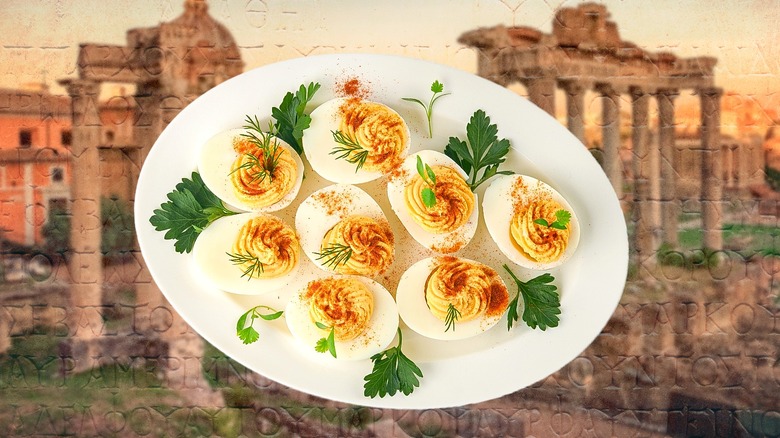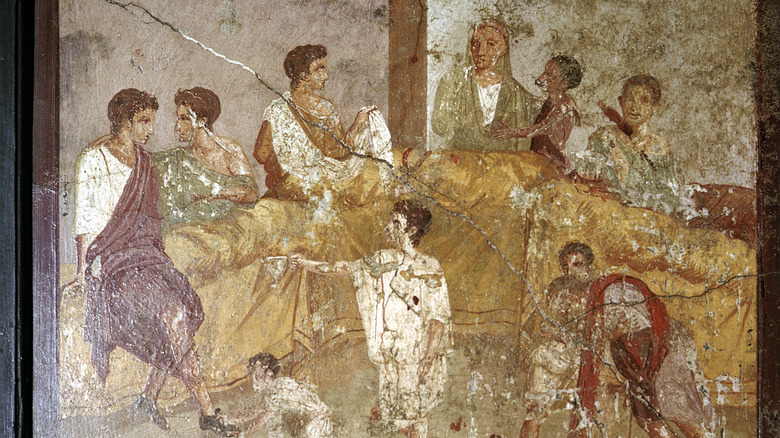The Truly Ancient Origins Of Deviled Eggs
Not many picnic-perfect canapés pack as much flavor into a single bite than a deviled egg. Whether you're preparing them for a party or a quick lunch, each hard-boiled egg half undergoes a delicious transformation as yolks are smashed with an array of spices, herbs, and condiments and stuffed back in. The word "deviled" comes from this act of seasoning, not the heinous nature of the process, as it refers to foods that are spicy, if not in the way of Scovilles then strong in flavor (via Britannica).
Today, most Americans make deviled eggs with mayonnaise, mustard, smoked paprika, and maybe some secret ingredients. According to author and food writer Anne Byrn, earlier takes on the hor d'oeuvres, such as a recipe printed in an Alabama newspaper in 1877, included vinegar and cayenne pepper instead. But although the well-seasoned, bite-sized snack has been a staple in the U.S. for over a century, deviled eggs didn't originate here, much less in modern times.
While it's impossible to confidently come to a conclusion about the age-old conundrum of the chicken-or-egg situation, there is a definitive answer to a different question: What came first, Spain or the deviled egg? Considering that the country formed in the late 1400s, it's hard to believe that the food could be older — but it is. In fact, the first deviled eggs hail from the ancient Roman Empire, although they didn't look like the ones eaten today. More recognizable versions were cooked up centuries later in medieval Andalusia when Muslims ruled much of the Iberian Peninsula.
Ancient Romans served spiced eggs at dinner parties
Ancient Romans started a fair share of culinary traditions that are still practiced in the modern age, from dressing salad to baking birthday cake. And although they can't be credited with the invention of the Caesar salad, they did create the first deviled eggs, sort of.
The custom of serving eggs to guests was standard host etiquette for ancient Romans. There's even a saying for the tradition: "Ab ovo usque ad mala," which means "from the egg to the apples." According to Merriam-Webster, the poet Horace wrote the phrase to describe how meals began with a course of eggs and ended with fruit. This starter often consisted of boiled eggs (sometimes mashed more like egg salad) with flavorful sauces of honey and garum, a fermented fish sauce.
While many Romans served spiced eggs at the start of their dinner parties, too, they were rather different from today's take on the appetizers. Seasoned and true to the term deviled? Yes. Stuffed? Not necessarily the same way. One version of a Roman egg dish is documented in Gaius Petronius' masterpiece "The Satyricon," written in the 1st century CE (via Guttenberg). Chapter 33 describes a lavish dinner party, featuring a course of pea-hen's eggs encased in pastry dough, stuffed with "a fine fat fig-pecker, embedded in a yolk seasoned with pepper." Modern recreations of the food have interpreted it as more of a chicken dumpling than a deviled egg, but, still, flavorful egg dishes were a staple at ancient feasts.
Modern deviled eggs first appeared in medieval Andalusia
Fortunately for deviled egg enjoyers, the fall of the Roman Empire in 476 CE didn't cause the seasoned starters to be lost to history. In the following centuries, Hispano-Muslims living throughout the Iberian Peninsula were still indulging in spiced eggs, but with new flavors and forms.
Stuffed eggs — more akin to today's deviled eggs — appeared in 13th-century medieval Muslim cookbooks from the historical kingdom of al-Andalus, or modern-day Spain. Only two such texts, including three of these recipes, survived for translation: the Fadalat and "An Anonymous Andalusian Cookbook of the 13th Century." Each calls for eggs to be boiled, peeled, then cut in half so the yolks can be scooped out. But as with most recipes, they diverge when it comes to seasoning. The one in the Fadalat recommends using "ground salt in moderation, pepper, ginger, cinnamon, cloves, spikenard, and a little mastic or ... a little cilantro and mint water." The Anonymous Andalusian Cookbook presents two options, though they shared cilantro and onion juice: either pepper, coriander, oil, salt, and murri (a fishy, umami-rish condiment in Arab cuisine that's comparable to Roman garum) or cinnamon and saffron. Finally, the stuffed eggs were dusted with flour and fried in fresh oil, then sprinkled with spices for serving.
While medieval Andalusian deviled eggs differed in ingredients, the process of stuffing eggs with a well-seasoned yolk is a culinary tradition still common today. And maybe it's worth taking some notes from the 800-year-old recipes, too — fried deviled eggs, anyone?


